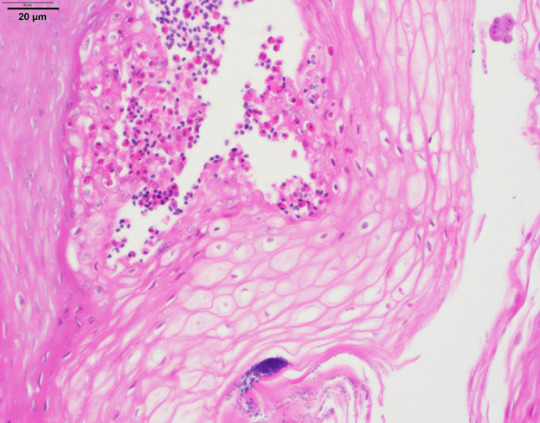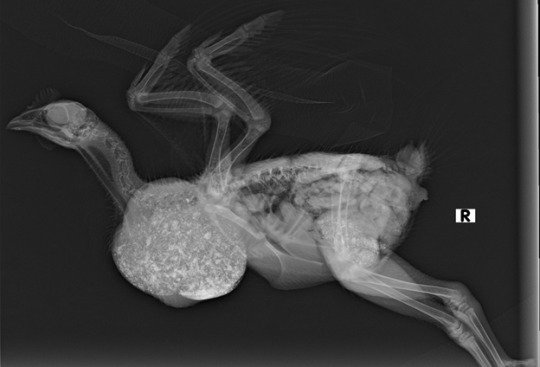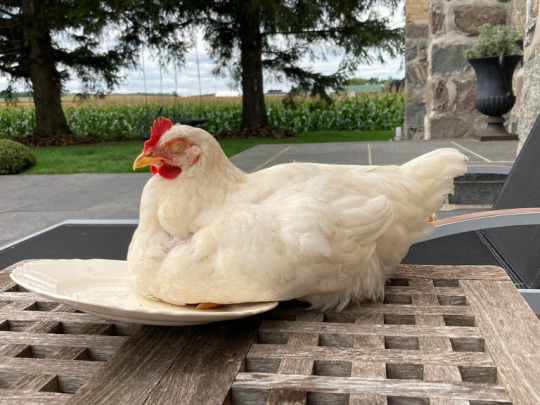#ingluvies
Text
My first chicken surgery!
I got to do my first ever bird surgery while on placements this past summer during my final year of vet med school :)
Lucky is an 8-week-old (at the time) Red Sex-link cockerel with a 5-week history of crop stasis, also known informally as “sour crop”. On physical examination, he did indeed have a distended crop with a doughy consistency (even after he'd been fasted for almost 18 hours before his appointment), and when I palpated his keel I found he had a body condition score of 1.5 out of 5 with quite a bit of muscle wasting, meaning that he was fairly emaciated. His owners also noted that although the distension did not cause him any apparent discomfort, he was smaller and had been growing at a noticeably slower rate compared to his brothers and even his sisters.
First off, what is crop stasis/sour crop? In birds, crop stasis is a common indicator of disease characterized by impaired motility and delayed emptying of the crop. There are several conditions that can lead to its development, including physical obstruction or impaction of the crop, which is typically caused by the ingestion of tough, fibrous vegetation or other foreign material that birb definitely should not have eaten, but did anyway. Decreased crop motility can additionally be the result of high environmental temperatures, prolonged time between feedings, heavy metal toxicosis, Marek’s disease, and many other things.
In order for me to figure out which of these things was going on with Lucky, I offered to perform a biopsy of his crop, which involves surgically cutting out a 1cm x 1cm square of the actual crop. And I figured, while I'm in there anyway, why not do something called an ingluviotomy? "Ingluvi-" referring to the crop, and "-otomy" meaning to cut into an organ or body cavity, usually with the intention of getting a good visual of its interior - and in the case of suspected impaction/foreign body obstruction, looking for said foreign body and safely removing it. (I was going to make a passionate plug in this post about how it saddens and terrifies me that people will attempt to do this "surgery" on their own at home without pain control or maintaining any sort of sterility but this post is long enough and that is a horrifying can of worms that I won't go into today.) Luckily for Lucky (heh), his owners were able to give me the ok to go ahead with this procedure, so I took him back to the hospital, sedated and anesthetized him, blocked the nerves around the area I'd be cutting into, took a biopsy sample, and did the ingluviotomy. This is what I took out of his crop.

Long blades of grass and/or pine needles, bits of sand/gravel, and a whole wasp-looking insect (black thing in the top/middle left). Once I finished digging all of that out, I gave Lucky's crop one last flush with some saline, gave him a dose of antibiotics and anti-inflammatory medication, and closed up his crop. Here he is waking up from his surgery, still feeling a little high and wrapped up in a towel with some heat pads:

I put the crop biopsy sample in some formalin and sent it off to my school's animal pathology lab, in along with a fecal sample and a swab I'd quickly taken of inside of his crop. The final report I got back a week later wasn't too exciting - no evidence of parasites and/or their eggs in the swab or poop sample, and microscopic evaluation of the biopsy just showed signs that the bird hadn't eaten in a while (which we already knew) and some inflammation, which also wasn't surprising. But here's the histology photo anyway, because it's pretty.

After returning home, Lucky was eating liquid food and taking his oral medications like a champ. The plot thickened though when his crop just filled right back up by the end of the first week following his surgery. So, I asked his owners to bring him back in for another exam. This time, his crop seemed to contain sludgy, liquid content only, but his body condition score was a 2.5 out of 5 and he'd put on a bit of muscle weight. I wasn't happy that his crop was still distended though and wanted to try to get to the bottom of it, so I sedated him again and took my first chicken x-ray:

Aside from the tennis-ball sized crop which seems to be filled with partially digested feed pellets and some grit, this is pretty much a normal x-ray. I was specifically looking for enlargement of the proventriculus or any other section of the GI tract that would indicate that there was a blockage somewhere along the line, but there's no evidence of that here. So, I sent Lucky back home with a prokinetic medication, and recommended that he start wearing a crop-supporting birdy bra (https://crazy-k-farm.myshopify.com/products/birdy-bra-crop-supporter-chest-protector).
It's been 2 months and Lucky's crop is still enlarged, but he looks great otherwise. He's gotten taller and started growing in his big boy feathers, and eats and drinks and behaves just like the other chickens in his flock. So why is his crop still like that? We really don't know. Secondary to crop stasis, the crop can become pendulous, i.e., enlarged and filled with an excessive amount of fluid. The exact cause of pendulous crops hasn't really been scientifically studied, despite their being a pretty common presenting complaint by owners of backyard poultry flocks. A few old studies suggest that there is a genetic component that results in poor muscle tone of the crop. I've also heard avian vets say that even after you fix the underlying cause of crop stasis in a bird, it can still end up with pendulous crop afterward if it was distended for a long enough period of time that the physical stretching and pressure on the crop wall damaged the nerves and muscles within. It's also possible that I might have accidentally traumatized one of these nerves during the biopsy and surgery, to be completely honest. Or, there could be some sort of unknown disease going on with Lucky's muscular system - certain muscular dystrophies in dogs and cats can result in impaired function of the esophagus (which the crop is a part of, in birds).
Whatever the cause, crop bras seem to be pretty popular among backyard flock owners who have the odd chicken or two with pendulous crops. Anecdotally, these birds seem to be more prone to re-developing crop stasis, but can apparently maintain a good quality of life with regular monitoring of appetite and body weight. It's been so far, so good for Lucky, at least!

(All photos belong to Lucky's owners and myself, please do not repost without permission)
References:
1. Worrell AB. Current trends in avian pediatrics. J Exot Pet Med 2012;21:115-123.
2. Morrisey JK. Gastrointestinal diseases in psittacine birds. Semin Avian Exot Pet 1999;8:66-74.
3. Greenacre CB, Morishita TY. Backyard poultry medicine and surgery: a guide for veterinary practitioners. Chichester, West Sussex, UK: John Wiley and Sons, 2021:292-293.
4. Ramesh R, Vijayanand V, Gopalakrishnand A, Ayyappan S. Crop impaction and its surgical management in a domestic fowl. J Entomol Zool Stud 2020;8:259-260.
5. Rigdon RH. Pendulous crop in the chicken: a pathologic study. Am J Vet Res 1961;22:379-381.
6. Rigdon RH, Ferguson TM, Couch JR. Spontaneous-occurring muscular necrosis in the chicken. Poultry Sci 1962;41:398-409.
7. Almeida EA, Silva FHA, Crowe TG, Macari M, Furlan RL. Influence of rearing temperature and feed format in the development of the pendulous crop in broilers. Poultry Sci 2018;97:3556-3563.
8. Brinkley C, Kingsley JS, Mench J. A method for guarding animal welfare and public health: Tracking the rise of backyard poultry ordinances. J Commun Health 2018;43:639-646.
9. Gosbell M, Fowler A. Gastrointestinal obstruction: a review, its diagnosis and treatment. Twentieth Association of Avian Veterinarians Australasian Committee Annual Conference Proceedings 2012:129-136.
10. McAtee BB, Heseltine JC, Guo LT, Willard MD, Shelton GD. Dysphagia and esophageal dysfunction due to dystrophin deficient muscular deficiency in a male Spanish water spaniel. Vet Quart 2018;38:28-32.
11. Gaschen F, Jaggy A, Jones B. Congenital diseases of feline muscle and neuromuscular junction. J Feline Med Surg 2004;6:355-366.
#veterinary medicine#veterinarian#backyard chickens#science#pet bird#pet chickens#original post#long post#biology#anatomy#pathology#rooster
170 notes
·
View notes
Note
alriiight mods! i think everything is in order and ready to go. acting on prior reserve, here's rize kamishiro from tokyo ghoul!
Welcome to Bellevue, Rize! Please make sure that you’re following everyone, and everyone follow her back!
☆ Mod E ~
1 note
·
View note
Text
Λαίμαργα: το δεύτερο συλλογικό έργο της Wunderart Productions (Λεμεσός: Εκδόσεις Ακτίς 2018)
Λαίμαργα: το δεύτερο συλλογικό έργο της Wunderart Productions (Λεμεσός: Εκδόσεις Ακτίς 2018)
H Λαιμαργία (ἀδηφαγία, γαστριμαργία, μαργοσύνη ή μαργότης στα αρχαία ελληνικά, ingluvies, immensa gula ή helluatio στα λατινικά) ήταν ένα από τα Επτά Θανάσιμα Αμαρτήματα της καθολικής θεολογίας. Ο Δάντης, στο έκτο Κάντο της Θείας Κωμωδίας,παρουσιάζει όσους κολάστηκαν «per la dannosa colpa de la gola» (6.53) να ζουν παγωμένοι και μουλιασμένοι στον Τρίτο Κύκλο της Κολάσεως, ανάμεσα στους…
View On WordPress
#"Λαίμαργα"#χρόνος#Εκδόσεις Ακτίς#Κυπριακή Λογοτεχνία#έρωτας#επτά θανάσιμα αμαρτήματα#κυπριακή πεζογραφία#κυπριακή ποίηση#καρκίνος#λαιμαργία#Wunderart Productions
0 notes
Text
Iodum: che cos’è, a cosa serve, tipo costituzionale e utilizzi omeopatici
Lo Iodum risulta essere una terapia curativa omeopatica di formazione Muriatica, con voce Tubercolinica a traccia Fluorica. La composizione dello Iodum tende ad utilizzare la Tintura Madre ricavata amalgamando 20 razioni di alcool con una di iodio.
Cos’è ed efficienza dello Iodum
Lo Iodum risulta essere un costituente conosciuto nel 1811 dallo studioso di chimica di nazionalità francese Bernard Courtois. Codesto costituente risulta essere alquanto esteso naturalmente, difatti lo troviamo:
all’interno dei minerali;
all’interno dei vegetali;
all’interno di liquidi degli abissi e all’interno di microrganismi del mare (animali di mare e alghe);
all’interno degli uomini laddove si ammassa essenzialmente all’interno della tiroide;
Seppur il quantitativo di Iodum vigente all’interno del corpo risulti esiguo, all’incirca 15-20 mg, risulta essere un minerale fondamentale per la riduzione di ormoni tiroidei, movente di cui l’80% di Iodum è presente ammassato all’interno della tiroide, ossia la ghiandola endocrina posizionata nell’area bassa della gola.
I doppi ormoni riassunti dalla tiroide e aventi al loro interno Iodium, ossia triiodotironina e tirosina, risultano essere essenziali al fine di aumentare la massa corporea e quella proteica, al fine di permettere l’ampliamento neurologico e al fine di regolarizzare la funzione di molteplici enzimi essenziali dell’anabolismo.
La sorgente essenziale di Iodum per l’anabolismo vivente tende ad essere raffigurata dai prodotti alimentari: gli aculei ed gli artropodi sono le tipologie che hanno al loro interno la maggior quantità di Iodum susseguendo le alghe. Gli stessi derivati del latte e le uova, ciò nonostante, favoriscono l’assimilazione di codesto minerale.
La terapia omeopatica di Iodum
Codesto minerale, risulta essere una terapia omeopatica di istituzione Muriatica, con diatesi tubercolinica a segno fluorico.
Tende ad essere raccomandato specialmente ai soggetti affetti da problemi cronici: nei soggetti infantili esili e scarni, con aumento d’altezza alquanto repentino o spesso ritardato. Però lo stesso vale per i soggetti femminili, le persone anziane e per soggetti affetti da demenza senile. Le persone esili, affettuose, approssimativamente o palesemente ipertiroidei, aventi stati d’ansia, nevrotici e alquanto deboli emozionalmente.
Lo Iodum tende ad essere pertanto raccomandato essenzialmente nel caso in cui subentrino problemi come:
Stato di indebolimento biologico malgrado la persona si alimenti in maniera corretta;
Senso di tachicardia, palpito arterioso propagato in qualsiasi parte del fisico;
Turbamento psico-motorio;
Ipertermia e accrescimento della sudorazione;
Ghiandola Tiroidea e omeopatia
La ghiandola tiroidea risulta essere una tiroide endocrina posizionata nella zona della gola, che espelle gli ormoni T3 e T4. L’ormone T3 risulta essere la conformazione attiva dell’ormone T4, e svolge l’azione di inneggiare l’azione dell’anabolismo e l’inumidificazione del sangue di qualsiasi tessuto, con l’esito di procurare ossigeno e corroboranti alle cellule accrescendo la celerità di utilizzo dei corroboranti energetici.
Nel momento in cui la ghiandola tiroidea “esercita esiguamente”, e dunque crea un quantitativo minimo di ormoni, si sta parlando di Ipotiroidismo. Le sintomatologie comunitarie dell’ipotiroidismo risultano essere:
Accidia;
Accrescimento di pesantezza;
Compressione;
Allentamento del battito;
Spossatezza;
Stato depressivo;
Peculiare percettibilità a temperature fredde;
Mestruo consistente;
Contrariamente nel momento in cui la ghiandola tiroidea “esercita esiguamente” e, nel flusso sanguigno, il concentramento ormonale è elevato, si sta parlando di ipertiroidismo. Codesto presupposto comporta un acceleramento di qualsiasi effetto metabolico laddove cooperano gli ormoni della tiroide. Le sintomatologie abituali vedono:
Perdita di peso;
Accelleramento del battito;
Impazienza;
Tremito all’organo tattile;
Agitazione;
Agrippina;
Gracilità muscolare;
Traspirazione sovrabbondante;
Lo Iodum risulta essere una terapia curativa omeopatica alquanto efficiente nel caso in cui si presentino problemi di Ipertirodismo, difatti se raccomandato con un minor vigore tende ad essere estremamente valevole al fine di ovviare codesto tipo di malessere.
Costituzione
Qualsiasi terapia curativa omeopatica è strettamente connessa ad una sistematica tipologia di costituzione; il tipo costituzionale dello Iodum mostra determinate proprietà:
Sintomatologie comuni
Tra le sintomatologie comuni di codesto tipo costituzionale fanno parte: adenopatia, idiosincrasia, cardiopalma, dispnea, infiammazione dei bronchi, dimagrimento, dissenteria, ingluvie, ipertiroidismo, laringospasmo, leucorrea, nevrosi compulsiva, nevrosi ansiolitica, polmonite, tremito interiore.
Sintomatologie localizzate
Lo Iodum risulta essere, principalmente, un prodotto farmaceutico comune. Tra le sintomatologie localizzate dello Iodium è possibile evidenziare l’instabilità delle funzioni e patologie dell’organo da colpire del prodotto farmacutico: la ghiandola tiroidea. Per questo motivo si avrà ingluvie ampio e dolente, ipotrofia dell’organo riproduttivo, reuma precorso da dissenteria, laringite, perdite bianche acide che “corrodono la lingerie”, raffreddore da casotto, linfoadenopatia estesa contrassegnata da linfonodi doloranti a compattezza solida, tachicardia, esoftalmo.
Sintomatologie della mente
Ne sono affetti persone scosse, accelerate, affette da nervosismo, inquieto. Le persone possono avvertire uno stimolo nel momento in cui è costretto a mantenere l’inattività e la fermezza. In aggiunta ha ambizione di controllo complessivo su qualsiasi cosa, fissazione e disturbo ossessivo compulsivo.
Risulta, alla fine, un presupposto causato da ipertitoidismo che comporta un acceleramento dell’anabolismo. A tale condizione vi è nervosismo mentale e esilità, eccessivo dimagrimento, ingordigia frugale.
Alfine le corrispettive sintomatologie:
si aggravano con le temperature alte generalizzate e localizzate, con la mancata mobilità specialmente se costretta, con la privazione di cibo;
si ristabiliscono con le temperature fresche localizzate e generalizzate (risulta essere un soggetto esuberante che tende a sudare in maniera sovrabbondante, seppur possa avere i piedi gelidi), ingerendo cibo, camminando e ad ambienti aperti.
Fonte: https://yesnaturaonline.com/iodum-che-cose-a-cosa-serve-tipo-costituzionale-e-utilizzi-omeopatici/
0 notes
Note
hello mods! i'd like to drop rize kamishiro, it just didn't work. maybe i'll bring her back at another time c: while i'm at it, can i place a reserve on severa from fire emblem? today is February 12, thank you!
Aw, well thank you for playing her while you did! I’m certain that she will surely be missed, and don’t forget you’re definitely more than welcome to bring her back later in the future!
Rize has dropped, please unfollow!
On the other hand, Severa from Fire Emblem as been reserved for you until February 19th! Please have your blog submitted by then!
▹ Mod K
0 notes
Photo

by ingluvies http://ift.tt/1NAMEUS
4 notes
·
View notes